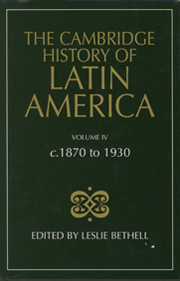Book contents
- Frontmatter
- 1 Latin America and the international economy, 1870–1914
- 2 Latin America and the international economy from the First World War to the World Depression
- 3 Latin America, The United States and the European powers, 1830–1930
- 4 The population of Latin America, 1850–1930
- 5 Rural Spanish America, 1870–1930
- 6 Plantation economies and societies in the Spanish Caribbean, 1860–1930
- 7 The growth of Latin American cities, 1870–1930
- 8 Industry in Latin America before 1930
- 9 The urban working class and early Latin American labour movements, 1880–1930
- 10 Political and social ideas in Latin America, 1870–1930
- 11 The literature, music and art of Latin America, 1870–1930
- 12 The Catholic Church in Latin America, 1830–1930
- Bibliographical essays
- Index
- References
5 - Rural Spanish America, 1870–1930
Published online by Cambridge University Press: 28 March 2008
- Frontmatter
- 1 Latin America and the international economy, 1870–1914
- 2 Latin America and the international economy from the First World War to the World Depression
- 3 Latin America, The United States and the European powers, 1830–1930
- 4 The population of Latin America, 1850–1930
- 5 Rural Spanish America, 1870–1930
- 6 Plantation economies and societies in the Spanish Caribbean, 1860–1930
- 7 The growth of Latin American cities, 1870–1930
- 8 Industry in Latin America before 1930
- 9 The urban working class and early Latin American labour movements, 1880–1930
- 10 Political and social ideas in Latin America, 1870–1930
- 11 The literature, music and art of Latin America, 1870–1930
- 12 The Catholic Church in Latin America, 1830–1930
- Bibliographical essays
- Index
- References
Summary
Introduction
Any attempt to treat the rural history of such a large and varied area as that embraced by the term Spanish America must first make clear the conceptual difficulties and the limitations imposed by uneven research. One approach has been to divide the entire area by elevation into lowland and highland or by zones of plantations and haciendas. This permits a broad and useful distinction between the sugar-producing, former slave regions such as the Antilles and the classic hacienda-dominated landscape of central Mexico or the Ecuadorian highlands. But the usefulness of this scheme disintegrates as one attempts to squeeze additional regions into it. The Cuautla depression in the Mexican state of Morelos, or Salta in Argentina, for example, both had many of the features of plantation life, such as capital intensive sugar centrales and a modern national market, but their labour force was drawn mainly from the smallholder Indian peasantry.
Another typology can be drawn along vegetative lines, that is, to examine rural society in terms of the crop it produces. To the extent that coffee or tobacco or sugar do in fact produce certain common or general requirements this scheme is useful, but only up to a certain point. The coffee plantations of Cundinamarca led to a very different society from that found among the independent smallholder coffee growers of Caldas or Costa Rica. And while it is true that the classic hacienda built on the high culture remnants of Mesoamerica and the Andean highlands shared several features, there are wide ethnic and cultural differences among both landowners and village workers.
- Type
- Chapter
- Information
- The Cambridge History of Latin America , pp. 151 - 186Publisher: Cambridge University PressPrint publication year: 1986
References
- 7
- Cited by

